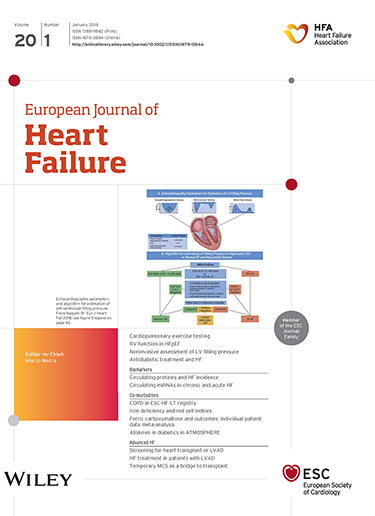全球心力衰竭流行病学与关键试验的纳入:一个可怕的不匹配
IF 16.9
1区 医学
Q1 CARDIAC & CARDIOVASCULAR SYSTEMS
引用次数: 0
摘要
为国际临床实践指南提供信息的随机临床试验(rct)应充分代表疾病负担严重的地区。我们的目的是评估关键心力衰竭(HF)随机对照试验的地理代表性,采用两种方法学方法。方法和结果我们使用全球疾病负担2021数据集评估HF病例的全球地理分布。然后,我们使用两个指标评估了已经形成国际指南的关键3期随机对照试验的地理代表性:代表性指数(RI),区域试验地点与疾病分布的比率,以及参与者与患病率比率(PPR),区域试验参与者与疾病分布的比率。2021年,全球有5540万心衰患者,其中亚洲人口最多(50%),其次是欧洲(18%)、非洲(14%)、北美(10%)和中美;南美洲(8%)。小反刍兽疫的估计受到试验在报告参与者入组时对地区进行分类的差异的限制。然而,RI和PPR的估计显示了相似的地理代表性估计。欧洲(RI: 2.41, PPR: 2.69)和北美(RI: 3.25, PPR: 2.58)在试验中被过度代表,而亚洲(RI: 0.26, PPR: 0.22)和非洲(RI: 0.14, PPR: 0.05)的代表性严重不足。相比之下,中央银行(Central &;南美洲(RI: 1.29, PPR: 1.59)有充分代表。结论:心力衰竭随机对照试验的证据主要来自欧洲和北美,非洲和亚洲的代表性严重不足。RI和PPR是区域代表性的相关指标,强调区域参与者入学率与一个区域的试验地点数量有关。与小反刍反应不同,RI可在试验计划期间进行估计,并指导试验设计,以获得更好的区域代表性。本文章由计算机程序翻译,如有差异,请以英文原文为准。
Global heart failure epidemiology versus enrolment in pivotal trials: A formidable mismatch
AimsRandomized clinical trials (RCTs) that inform international clinical practice guidelines should adequately represent regions burdened with disease. We aimed to assess the geographic representativeness of pivotal heart failure (HF) RCTs using two methodological approaches.Methods and resultsWe assessed the global geographic distribution of HF cases using the Global Burden of Disease 2021 dataset. We then assessed the geographic representativeness of pivotal phase 3 RCTs that have shaped international guidelines using two metrics: the representation index (RI), a ratio of regional trial sites to disease distribution, and the participant‐to‐prevalence ratio (PPR), a ratio of regional trial participants to disease distribution. In 2021, there were 55.4 million people with HF worldwide, with the greatest population in Asia (50%), followed by Europe (18%), Africa (14%), North America (10%), and Central & South America (8%). PPR estimates were limited by the variation in how trials classified regions when reporting participant enrolment. Yet, RI and PPR estimates revealed similar estimates of geographic representation. Europe (RI: 2.41, PPR: 2.69) and North America (RI: 3.25, PPR: 2.58) were over‐represented in trials, while Asia (RI: 0.26, PPR: 0.22) and Africa (RI: 0.14, PPR: 0.05) were grossly under‐represented. In contrast, Central & South America (RI: 1.29, PPR: 1.59) were adequately represented.ConclusionsPivotal HF RCTs generate evidence primarily from Europe and North America, and grossly under‐represent Africa and Asia. RI and PPR are correlated measures of regional representativeness, highlighting that regional participant enrolment is related to the number of trial sites in a region. Unlike PPR, RI can be estimated during trial planning and guide trial design for better regional representativeness.
求助全文
通过发布文献求助,成功后即可免费获取论文全文。
去求助
来源期刊

European Journal of Heart Failure
医学-心血管系统
CiteScore
27.30
自引率
11.50%
发文量
365
审稿时长
1 months
期刊介绍:
European Journal of Heart Failure is an international journal dedicated to advancing knowledge in the field of heart failure management. The journal publishes reviews and editorials aimed at improving understanding, prevention, investigation, and treatment of heart failure. It covers various disciplines such as molecular and cellular biology, pathology, physiology, electrophysiology, pharmacology, clinical sciences, social sciences, and population sciences. The journal welcomes submissions of manuscripts on basic, clinical, and population sciences, as well as original contributions on nursing, care of the elderly, primary care, health economics, and other related specialist fields. It is published monthly and has a readership that includes cardiologists, emergency room physicians, intensivists, internists, general physicians, cardiac nurses, diabetologists, epidemiologists, basic scientists focusing on cardiovascular research, and those working in rehabilitation. The journal is abstracted and indexed in various databases such as Academic Search, Embase, MEDLINE/PubMed, and Science Citation Index.
 求助内容:
求助内容: 应助结果提醒方式:
应助结果提醒方式:


